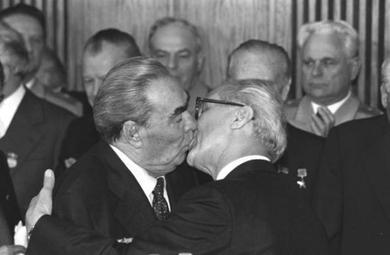First published in 2017 on Teaing like Russians
Many Americans comment on how much in-your-face PDA (public display of affection) there is in Russia. My cousin, who studied abroad in Moscow, moaned that Russia is “just the worst country to be single in,” because every day you ride the train and watch couples hug and kiss, kiss a LOT.
But the confusion doesn’t end there. After spending time in Russia, I get awkward even when somebody goes for the simple greeting kiss. Inside, I’m wondering just how many times I’m supposed to kiss their cheeks. In America, one peck is more than enough. But then French people kiss your cheek twice; would they think that I’m insinuating something if I go for the third one by habit?
Because the standard Russian greeting kiss is the triple kiss, in which you kiss the other person three times, alternating cheeks. Traditionally, this symbolizes the Trinity, so many Russians unknowingly, greet each other in the name of the Father, Son and Holy Spirit daily.
So what is Russia’s kiss culture history?
Here’s a little bit of info on the question, loosely based on a translation of an article from cyrillitsa.ru.

The Triple Kiss
The three time kiss in Russia was the typical way of showing your openness and welcome to a guest. This guest kiss was a kiss laden with endless meaning, since a guest in Ancient Russia was a messenger of fate, one who could both bring luck or doom to the life of the household.
Later, in Christian Russia, a guest was considered to be God’s messenger, so people were sincerely, intensely eager to show mercy and hospitality to a messenger of God, who like Christ, had nowhere to stay.
The Diplomatic Kiss
In ancient diplomatic ceremonies, how and when one paid respects to the emperor was incredibly important. In Russia, like in many Eastern countries, one kissed the hand of a respected person. In ancient times, even a respected foot could warrant a kiss.
How Men Kiss
The scandalous Brezhnev kiss is NOT how modern Russian men greet each other. However, it’s totally normal for Russian men to greet each other with a male version of the triple kiss: they lean in three times for a some quick cheek to cheek contact.

The Status Kiss
A person of lower social class person could kiss a higher-ranked person on the shoulder, whereas a higher ranker person could condescend to kiss the lower (in all respects) human on the tip of the head
The Infamous Tartar Kiss
In the 15th century, the kiss that we call today “French” was called a “Tartar” kiss. Why? Because before the invasion of the Tartars (a hotblooded, passionate people), the Russians had no idea such shenanigans existed.
Only in the 18th century, this kiss was renamed to “French Kiss,” which reflects a tendency common to the literature of the time: to assign all harmful practices to foreigners and foreign cultures (Tatars lived in Russian and were therefore considered to be “one of us”).
Back in the day, these French nee Tartar kisses were condemned by clergy, even incurring a punishment: 12 to 20 days of fast after an open-mouthed kiss. But though this sounds harsh for the modern person, the punishment was actually quite lenient and light for the time.

Be CompleteThe Russian word “kiss” comes from the word whole….in a kiss one searches for completeness; it is a desire to be wholesome and whole. This is why this gesture is often accompanied by well-wishes. Though “kissing” has been perverted by modern culture to necessarily connote something carnal, the intent, the logic behind a kiss historical is not vulgar; but rather a natural expression of an essential human desire: for connection and wholeness.
The Protecting Kiss
In folklore, the kiss was also a way to destroy dark magic and break evil spells (think back to Sleeping Beauty). Even today, what do we do when a child who falls and hurts himself? We kiss the place that hurts, in order to comfort, in order to heal, in order to make it “whole” again.
Kissing Items
The power of the kiss could be aimed not only at a person but at other parts of Creation.
For example, ancient Slavs considered kissing the earth to be the most awful, the most powerful promise; an infringement of such a promise could cause death. After Christianity, kissing the earth was replaced by kissing the Cross. In fact, kissing the cross became the official legal procedure in all important personal and governmental actions. No one kissed the cross lightly.
To this day, kissing icons, holy items, hands or clothing of church representatives and hierarchs remains a tradition; it’s another example of kissing in the search to get healing, to find health and wholeness again.